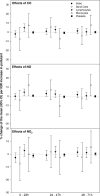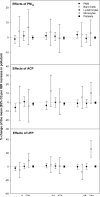Impact of ambient air pollution on the differential white blood cell count in patients with chronic pulmonary disease
- PMID: 20064088
- PMCID: PMC3877919
- DOI: 10.3109/08958370903207274
Impact of ambient air pollution on the differential white blood cell count in patients with chronic pulmonary disease
Abstract
Epidemiologic studies report associations between particulate air pollution and increased mortality from pulmonary diseases. This study was performed to examine whether the exposure to ambient gaseous and particulate air pollution leads to an alteration of the differential white blood cell count in patients with chronic pulmonary diseases like chronic bronchitis, chronic obstructive pulmonary disease, and asthma. A prospective panel study was conducted in Erfurt, Eastern Germany, with 12 repeated differential white blood cell counts in 38 males with chronic pulmonary diseases. Hourly particulate and gaseous air pollutants and meteorological data were acquired. Mixed models with a random intercept adjusting for trend, meteorology, weekday, and other risk variables were used. In this explorative analysis, we found an immediate decrease of polymorphonuclear leukocytes in response to an increase of most gaseous and particulate pollutants. Lymphocytes increased within 24 h in association with all gaseous pollutants but showed only minor effects in regard to particulate air pollution. Monocytes showed an increase associated with ultrafine particles, and nitrogen monoxide. The effect had two peaks in time, one 0-23 h before blood withdrawal and a second one with a time lag of 48-71 h. The increase of particulate and gaseous air pollution was associated with multiple changes in the differential white blood cell count in patients with chronic pulmonary diseases.
Figures


Similar articles
-
The influence of improved air quality on mortality risks in Erfurt, Germany.Res Rep Health Eff Inst. 2009 Feb;(137):5-77; discussion 79-90. Res Rep Health Eff Inst. 2009. PMID: 19554968
-
Daily mortality and fine and ultrafine particles in Erfurt, Germany part I: role of particle number and particle mass.Res Rep Health Eff Inst. 2000 Nov;(98):5-86; discussion 87-94. Res Rep Health Eff Inst. 2000. PMID: 11918089
-
Exposure to air pollution near a steel plant and effects on cardiovascular physiology: a randomized crossover study.Int J Hyg Environ Health. 2014 Mar;217(2-3):279-86. doi: 10.1016/j.ijheh.2013.06.007. Epub 2013 Jul 5. Int J Hyg Environ Health. 2014. PMID: 23911139 Clinical Trial.
-
The potential impacts of climate variability and change on air pollution-related health effects in the United States.Environ Health Perspect. 2001 May;109 Suppl 2(Suppl 2):199-209. doi: 10.1289/ehp.109-1240667. Environ Health Perspect. 2001. PMID: 11359687 Free PMC article. Review.
-
Health effects of outdoor air pollution. Committee of the Environmental and Occupational Health Assembly of the American Thoracic Society.Am J Respir Crit Care Med. 1996 Jan;153(1):3-50. doi: 10.1164/ajrccm.153.1.8542133. Am J Respir Crit Care Med. 1996. PMID: 8542133 Review.
Cited by
-
Influence of air pollutants on circulating inflammatory cells and microRNA expression in acute myocardial infarction.Sci Rep. 2022 Mar 30;12(1):5350. doi: 10.1038/s41598-022-09383-7. Sci Rep. 2022. PMID: 35354890 Free PMC article.
-
Vascular and lung function related to ultrafine and fine particles exposure assessed by personal and indoor monitoring: a cross-sectional study.Environ Health. 2014 Dec 15;13:112. doi: 10.1186/1476-069X-13-112. Environ Health. 2014. PMID: 25512042 Free PMC article.
-
Genome-Wide Analysis of DNA Methylation and Fine Particulate Matter Air Pollution in Three Study Populations: KORA F3, KORA F4, and the Normative Aging Study.Environ Health Perspect. 2016 Jul;124(7):983-90. doi: 10.1289/ehp.1509966. Epub 2016 Jan 5. Environ Health Perspect. 2016. PMID: 26731791 Free PMC article.
-
The Association of White Blood Cells and Air Pollutants-A Population-Based Study.Int J Environ Res Public Health. 2021 Mar 1;18(5):2370. doi: 10.3390/ijerph18052370. Int J Environ Res Public Health. 2021. PMID: 33804362 Free PMC article.
-
Air pollution and DNA methylation: effects of exposure in humans.Clin Epigenetics. 2019 Sep 3;11(1):131. doi: 10.1186/s13148-019-0713-2. Clin Epigenetics. 2019. PMID: 31481107 Free PMC article. Review.
References
-
- Brook RD, Franklin B, Cascio WE, Hong Y, Howard G, Lipsett M, Luepker RV, Mittleman MA, Samet JM, Smith SC, Jr., Tager IB. Air Pollution and Cardiovascular Disease: A statement of the health care professionals from the expert panel on population and prevention science of the American Heart Association. Circulation. 2004;109:2655–2671. - PubMed
-
- Cyrys J, Stolzel M, Heinrich J, Kreyling WG, Menzel N, Wittmaack K, Tuch T, Wichmann HE. Elemental composition and sources of fine and ultrafine ambient particles in Erfurt, Germany. Sci Total Environ. 2003;305:143–156. - PubMed
-
- Fujii T, Hayashi S, Hogg JC, Mukae H, Suwa T, Goto Y, Vincent R, van Eeden SF. Interaction of alveolar macrophages and airway epithelial cells following exposure to particulate matter produces mediators that stimulate the bone marrow. Am J Respir Cell Mol Biol. 2002;27:34–41. - PubMed
-
- Ghio AJ, Hall A, Bassett MA, Cascio WE, Devlin RB. Exposure to concentrated ambient air particles alters hematologic indices in humans. Inhal Toxicol. 2003;15:1465–1478. - PubMed
-
- Hildebrandt K, Rückerl R, König W, Schneider A, Heinrich J, Marder V, Frampton M, Oberdörster G, Wichman H, Peters A. Short-term variation of inflammatory markers in chronic obstructive pulmonary disease (COPD) patients.. International Conference on Environmental Epidemiology and Exposure (ISEE); Pasadena, USA. 2008.
Publication types
MeSH terms
Substances
Grants and funding
LinkOut - more resources
Full Text Sources
Medical
